The trend in engine downsizing continues to grow, thanks to its ability to lower fuel consumption and emissions whilst delivering the performance of a larger engine. With global warming gaining more significance – and automotive technology playing a part in rising global emissions – the responsibilities of OEMs, suppliers and other stakeholders to work towards reduction has increased considerably.
Diesel engines have often been the forerunners for new powertrain technologies, so it comes as no surprise that downsizing earned its credentials in this area too. In fact, one might even say that the dominance of diesel engines in Europe is synonymous with downsizing, enabled by the combination of turbocharging and CRDi.
The trend in engine downsizing continues to grow, thanks to its ability to lower fuel consumption and emissions whilst delivering the performance of a larger engine.
However, the trend is visibly shifting from diesel to gasoline engines: a number of OEMs have begun applying turbocharging and direct injection technologies to Euro5 gasoline engines. And advanced boosting solutions with the potential to enable 50% downsizing are already in development.
According to Frost & Sullivan data, nearly 70% of diesel powertrains in 2018 will have displacements of between 1.3 and 2.2 litres, with the 1.8 to 2.2 litres group comprising the largest share. Moreover, nearly 60% of gasoline powertrains are expected to have displacements of between 1.0 and 1.4 litres, with the 1.0 to 1.2 litre group accounting for the largest proportion.
Unlike diesel powertrains, which only use turbochargers, gasoline powertrains bid to downsize will see the use of different boosting technologies, accounting for around 50-55% of gasoline engines by 2020. These include: geometry, variable geometry and multi-stage turbo, superchargers and even electric superchargers – although the fixed geometry turbocharger will be preferred.
Engine downsizing, concurrent with boosting, increases power irrespective of the type of powertrain. Currently, the focus for diesel engines is on rightsizing – after all, further downsizing of a diesel engine only leads to an increase in specific power and thus increases NOx emissions.
The ICE, it seems, will be at the heart of motoring for years to come, although its objective will shift – moving from being the sole prime-mover to supporting electric drives, as seen in the Chevrolet Volt.
On the other hand, the implementation of turbocharging and GDI brings about a new challenge for gasoline engines with regards to particulate matter emissions – as seen in Euro5 and Euro6 norms for gasoline powertrains and NOx emissions, especially with stratified GDI.
Taking into account diesel powertrain trends, it is logical to conclude that gasoline downsizing will also reach the point where there too has to be a balance between downsizing and PM/NOx emissions.
This does not mean, however, that rightsizing will limit internal combustion engines (ICEs) to 1.0-litre gasoline and 1.2-litre diesel engines. While rightsizing is the predicted future, downsizing of engine displacement is a reality. Increasing powertrain electrification makes transient ICE performance redundant. The ICE will only need to cater to the baseline continuous power demand. The ICE, it seems, will be at the heart of motoring for years to come, although its objective will shift – moving from being the sole prime-mover to supporting electric drives, as seen in the Chevrolet Volt.
The opinions expressed here are those of the author and do not necessarily reflect the positions of Automotive World Ltd.
Bharath Kumar Srinivasan is a Senior Research Analyst at Frost & Sullivan.
The AutomotiveWorld.com Expert Opinion column is open to automotive industry decision makers and influencers. If you would like to contribute an Expert Opinion piece, please contact editorial@automotiveworld.com.



